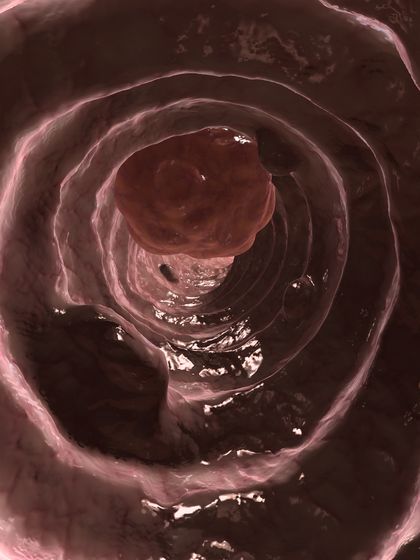Polyps

Polyps (POL-ips) are growths of tissue that project from the mucous membranes * These growths normally are benign (be-NINE), which means they are not a threat to someone's health, but in some cases they can develop into cancerous tumors.
KEYWORDS
for searching the Internet and other reference sources:
Cervical polyps
Colorectal polyps
Nasal polyps
What Are Polyps?
Three of the most common types include colorectal, cervical, and nasal polyps.
* mucous membranes (MU-kus membranes) are the thin layers of tissue found inside the nose, ears, cervix (SER-viks) and uterus, stomach, colon and rectum, on the vocal cords, and in other parts of the body.
Colorectal polyps
These polyps grow in the colon or rectum, parts of the large intestine. They can develop into cancerous polyps. People who have colorectal polyps may notice unusual cramping, stomach pain, or bleeding when they have a bowel movement, or they may not experience any symptoms at all. Doctors usually check for polyps in people who have these symptoms, or who have relatives that were diagnosed with colorectal polyps, since sometimes polyps run in families. Most colorectal polyps develop in people over age 50.
The most common procedures for diagnosing colorectal polyps are sig-moidoscopy (sig-moyd-OS-ko-pee), an examination of the rectum and lower colon, and colonoscopy (ko-lon-OS-ko-pee), an examination of the rectum and the entire colon. The doctor inserts a flexible lighted instrument into the colon that transmits images of the inside of the colon to a monitor. If polyps are found, they are removed to prevent the development of cancer.
Cervical Polyps
These growths develop in the cervix, which is the lower part of the uterus * . Their cause is not completely understood, but they are not related to any type of sexually transmitted disease.
The most common symptom of cervical polyps is abnormal bleeding from the vagina * . Cervical polyps are relatively common and are usually found during a woman's annual pelvic examination, when the doctor checks the uterus, cervix, and vagina for any abnormalities. Most cervical polyps are benign and can be removed easily. Only rarely do they develop into cancer.
Nasal Polyps
Nasal polyps develop in the sinuses, the cavities in the skull that are located near the top of the nose and under the eyes. People who develop nasal polyps usually have a history of allergies, hay fever, sinus infections, asthma * , or cystic fibrosis * . They can cause problems with breathing and either need to be removed or treated with medications that the person inhales. Nasal polyps rarely become cancerous.
* uterus (YOO-ter-us) in humans is the organ in females for containing and nourishing the young during development in the period before birth. Also called the womb.
* The vagina is the canal that leads from the uterus—the womb—to the outside of the body.
* asthma is a lung disorder that involves attacks of breathing difficulty.
* cystic fibrosis (SIS-tik fy-BRO-sis) is an inherited disorder in which the body's glands release very thick mucus. This can lead to blockages and infection in the lungs.
See also
Allergies
Colorectal Cancer
Cystic Fibrosis
Resources
Organization
The Mayo Clinic, Rochester, MN, posts information about colorectal and
nasal polyps on its website.
http://www.mayo.edu/
Comment about this article, ask questions, or add new information about this topic: